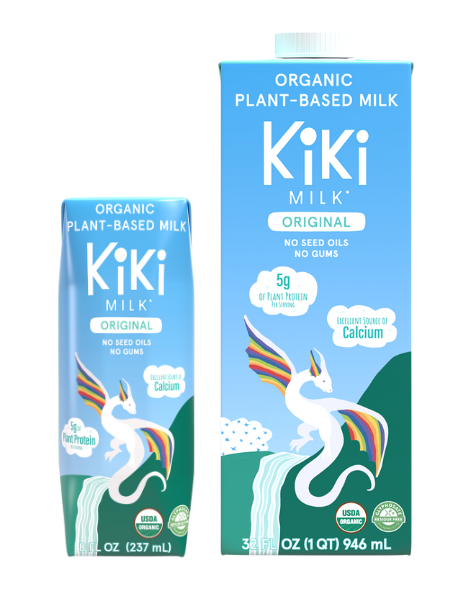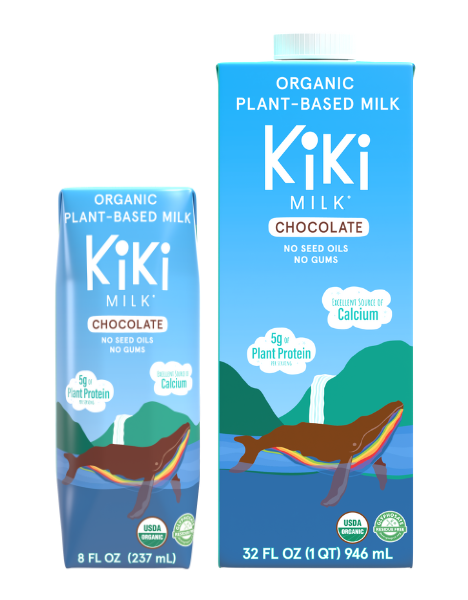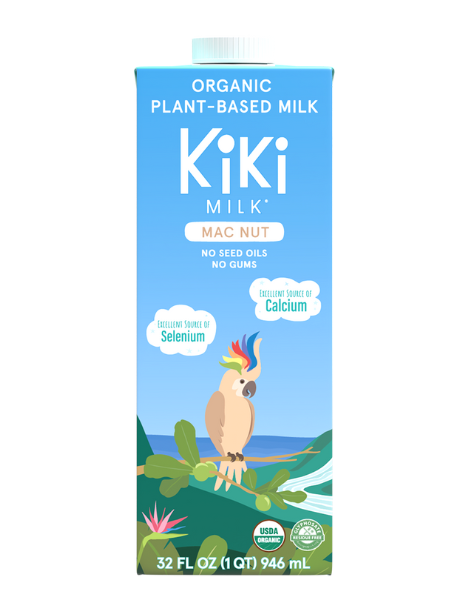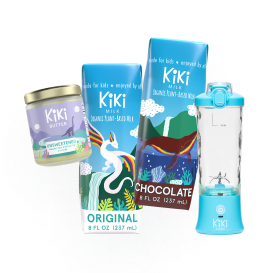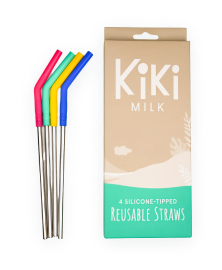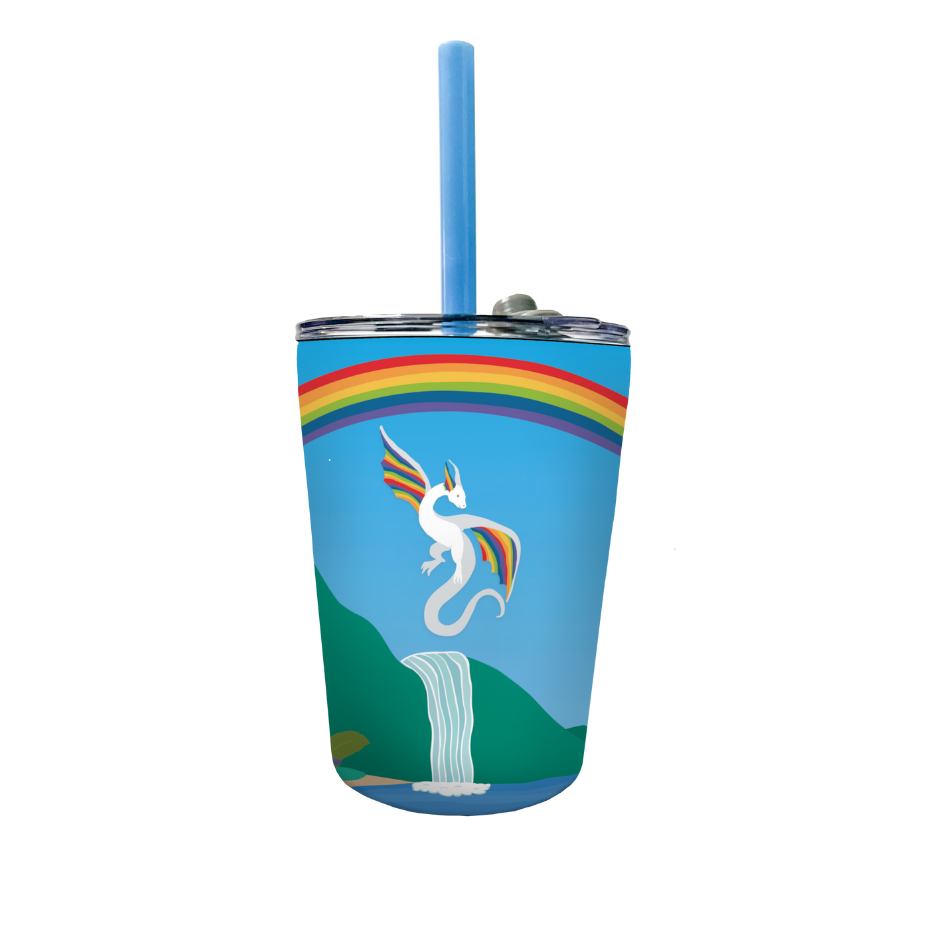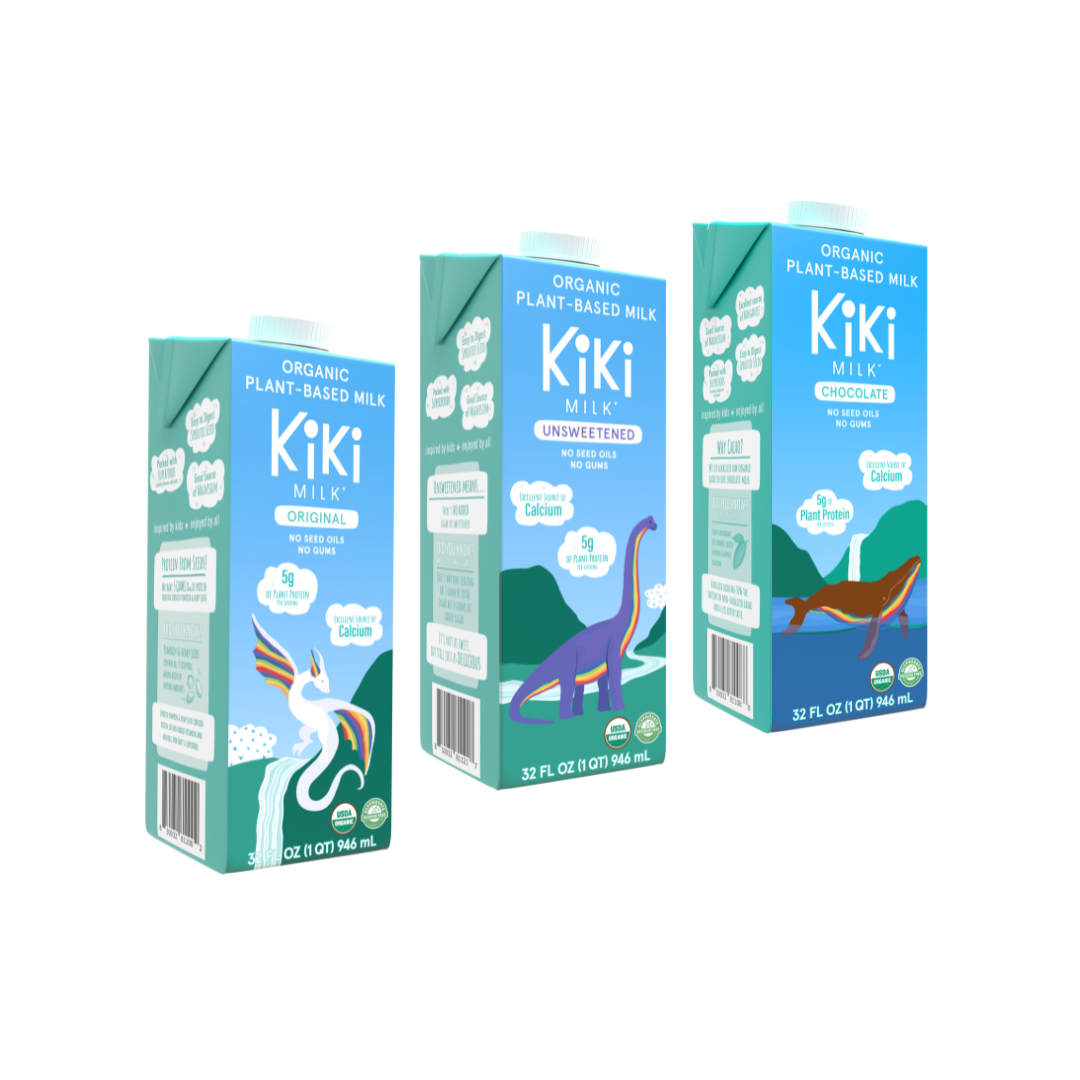Frequently asked questions
-
What makes Kiki Milk great for kids?
Kiki Milk is great for kids because...
⭐ We use none of these things: (no gums, seed oils, refined sugars, preservatives, GMOs, glyphosate, gluten, or soy)
⭐ We do not add any ’natural’ or artificial sweeteners, flavors or colors
⭐ We only source organic whole food ingredients
⭐ Kiki Milk Original and Chocolate are nut free* (we do use coconut)
⭐ Although we are totally organic, we go above and beyond to 3rd party lab-test all our sourced ingredients in an effort to be extra safe because we want to make sure our products do not contain any glyphosate (a common pesticide that is pervasive in US foods) or other harmful substances
⭐ We work closely with leading pediatricians and nutritionists to deliver clean, plant-based milks that support the nutritional needs of growing kiddos
Read our full blog post on why Kiki Milk is great for kids here. -
At what age can my child start drinking Kiki Milk?
Generally, doctors and pediatricians recommend mainly breastmilk or formula for children until the age of one. *After one, they can begin to transition to regular milk or other milk alternatives.
According to our nutritionist, Vicki Kobliner, MS RDN, CD-N, organic whole food sources are especially important for young kids since they are still developing. Kiki Milk is made with only organic whole food ingredients and contains no gums, seed oils, refined sugars, preservatives, GMOs, glyphosate, gluten, nuts (except coconuts), or soy. To learn more about why Kiki Milk's is great for kids, read our blog post here. For practical advice, talk to your child's pediatrician.
*Kiki Milk is not meant to replace breast milk or infant formula. -
Are your products made on shared equipment that processes any of the top 8 allergens?
Kiki Milk is made in a peanut-free facility. We do, however, share our line with products that contain: Soy, Milk, Wheat, Egg, Fish, Tree Nut, Sunflower, Sulfites, Sesame, Celery, and Tomatoes.
That being said, we have stringent Quality Assurance procedures in place that require cleaning 🧼, inspection 🔍️, and testing 🧪 of the equipment to ensure that any presence of a big 8 allergen is removed from our production lines ✨BEFORE✨ processing our product.
We also take it a step further ✅ and test our final product for allergens to confirm and verify that our procedures are operating as designed and that all of our claims are accurate 💯.
If you have any specific questions or concerns, do not hesitate to reach out to us at kikimilk@plantbaby.co. -
How long does Kiki Milk stay fresh?
Thanks to our shelf-stable packaging, unopened Kiki Milk will keep safe and flavorful for at least 12 months (or by the “Best if Used By” date) without refrigeration or preservatives! This means you can store it in your pantry or even take it with you when traveling.
However, once you are ready to enjoy Kiki Milk, we highly recommend drinking it cold for the best experience. Simply add a few cartons (or the entire case 😉) of Kiki Milk into your fridge for at least 2 hours before consuming. Pro tip: The more you add to the fridge at once, the more you have on hand to enjoy later without waiting.
If you don’t finish a carton in a single sitting, no problem! Simply store it in the fridge until you are ready for more.
👉 8oz Kiki Milk stays fresh for 7-10 days in the fridge.
👉32oz Kiki Milk stays fresh for 10-14 days in the fridge, thanks to the nifty screw cap!
Just remember: Real food spoils. -
What's the deal with shelf-stable milk?
Thanks to some seriously awesome packaging and ultra-high temperature pasteurization (AKA UHT pasteurization), perishable foods are made shelf stable, meaning they do not need to be refrigerated unless opened. Pretty neat, huh?
🤯Tell me more.
Okay so, conventional dairy milk is heated up to at least 161 degrees for 15 seconds to kill harmful bacteria in the milk. With UHT, it is heated up to 280 to 300 degrees for two to six seconds. Both methods of pasteurization ensure safety and freshness.
In addition to this pasteurization process, sterile packaging and a sterile environment in which the packaging happens are key. First, the bottles are produced on site; they are then sterilized so that they are absolutely clean. Secondly, the milk packaged in those bottles is in a sterile environment so that no bacteria or pathogens can contaminate the product.
The combination of UHT pasteurization and bottling sterilization ensures that the milk lasts up to six months on the shelf without refrigeration.*
In case you are wondering, “Does shelf stability affect taste or nutrition? The answer is nope!
While it might seem more traditional to purchase cold oat milk, shelf-stable oat milk is just as delicious and nutritious as its refrigerated counterpart, and even has added benefits. It is easier to store, has a longer shelf life, often costs less to produce and ultimately is the more sustainable choice.
Learn more about our packaging supplier here. -
Why does Kiki Milk separate?
We don’t use emulsifiers, AKA chemical additives that bind ingredients together to make them artificially smooth, creamy, and pretty. If you see clumps, that’s actually a good sign. They indicate whole food ingredients which naturally separate. Just give your Kiki Milk a good shake before enjoying and you’ll experience the true taste of nature!
-
Is Kiki Milk Kosher-Certified?
We use Kosher-certified ingredients and our product is processed in a Kosher-certified facility, however, we do not have an official Kosher certification. We are looking to obtain this certification very soon!
-
What is Aquamin™ and how much calcium is in Kiki Milk?
Aquaman is a superhero that possesses superhuman strength, the ability to breathe underwater, and the capacity to communicate telepathically with creatures of the sea, among other powers. Drink Kiki Milk, and you just might be able to do the same!
But, actually:
Aquamin™ is a unique marine multi-mineral complex, providing bioactive calcium, magnesium and approximately 72 other trace marine minerals*. It supports bone health, reduces inflammation, and makes for a happier and healthier gut. It's a seaweed superfood.
Where does it come from?
⭐ Aquamin™ is extracted from the cell wall of the red marine algae, Lithathamnion calcareum, which is harvested from the cold Atlantic waters off the northwest and southwest coast of Ireland. Over the course of its 5-year lifespan, the algae absorb trace minerals from the sea, giving Aquamin™ its unique multi-mineral content. The algae are then naturally broken down and settled into the sea beds forming calcified skeletal remains, which are harvested with international standards for sustainable marine aquaculture.
Why do we use Aquamin™ in Kiki Milk?
⭐ For plant-based calcium! Thanks to some mighty seaweed, Kiki Milk Original has 228 mg of calcium per serving and Kiki Milk Chocolate has 229 mg of calcium per serving. That makes a pretty good dent in your daily calcium targets and gives you real food fuel to get you through the day.
*Aquamin™ contains a wide spectrum of trace minerals assimilated from sea water. Aquamin™ is a natural ingredient and trace mineral levels may vary over time. -
WHY IS THERE NO VITAMIN D IN KIKI MILK?
Vitamin D is critical for health and development, and we want every child that drinks Kiki Milk to have robust amounts in their body from the sun and clean supplementation. The problem is that the milk and milk alternatives can only be fortified with D2, and this form is not as well absorbed or metabolized as the more functional D3. These synthetic and isolated forms of the vitamin, D2, also include hidden sub-ingredients like maltodextrin we aren’t so keen on. Although companies aren’t required to put this on the label, we have ‘a no hidden sub-ingredients policy”. We choose integrity and transparency, and although most companies do it, we don’t agree with this practice.
Additionally, our bodies can naturally make D3 in the summer from sun exposure- 15 to 20 minutes before applying non-toxic sunscreen can do the trick. In fall and winter, one or two drops of a good quality D3 liquid supplement can provide the daily 600IU a toddler needs. It can even be added to your Kiki Milk before drinking.
You want the best for your kids and so do we. That's why we prefer not to add the inferior Vitamin D2, when we know D3 is a simple and better choice.
Read more about our ingredients and nutrition facts here. -
What is glyphosate and how can I avoid it?
Glyphosate is the world’s most commonly used herbicide. Since being patented in 1974, billions of pounds have been applied globally to agricultural crops, especially high value crops (e.g., tree nuts, grapes, vegetables) and large acreage field crops (e.g., soybean, cotton, corn). In the U.S. specifically, although we make up only 4% of the world’s population, we use 20% of the world’s glyphosate supply annually.* Then, we wonder why our rates of chronic disease are so much higher than other countries.
Although research is still being vastly conducted, recent studies have linked glyphosate to cancer, endocrine disruption, infertility, immune dysfunction, liver and kidney damage, and disruption of the microbiome. And not only is glyphosate harming human health and the health of our future generations, it’s also destroying our ecosystems.
So, how do we avoid glyphosate?
Purchasing USDA Organic or Non-GMO Project certified food helps, but, unfortunately these labels do not ensure the absence of glyphosate due to poor supply chain testing standards. The only way to guarantee that a product is glyphosate residue free is to third party test it, which we do with Kiki Milk.
Kiki Milk is proud to work with Farmer’s Footprint who is committed to restoring harmony in our food and agricultural systems. -
Why is there a sticker on my Kiki Milk carton?
Kiki Milk is processed and packaged in an aseptic carton that allows for a 24-month shelf life for safety markers like microbial levels, yeast, and mold.
However, since Kiki Milk is made with only organic whole food ingredients and no additives or preservatives, like so many other plant milks use, we opted for a conservative 12-month shelf life because we weren’t sure if the taste of our milk would sustain.
As we passed the one-year mark, we continued to taste and evaluate our milk, and when we hit the 2-year mark on our first production run of each flavor, we were confident we could extend the shelf life as the quality held! We always knew our product would be safe for 24 months, but this validated that we also created a product that would still taste amazing 24 months after it was made and packaged.
In an effort not to fill landfills with perfectly drinkable milk and unnecessary waste, we opted to sticker over the remaining inventory with the new best-by date. We understand this decision may have caused some confusion, and we apologize for any concerns this may have caused. Please do not hesitate to reach out to us if you have any questions at all!
